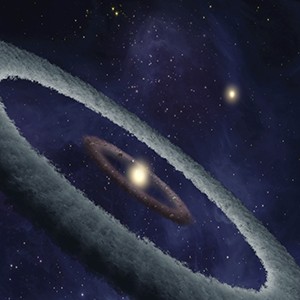NORMAN—A University of Oklahoma astrophysicist, Nathan Kaib, is modeling the early stages of the formation of the solar system with a new algorithm that will allow computer simulations to run on graphic processing units at the OU Supercomputing Center for Education and Research. Also, Kaib is modeling early stages of planets within binary star systems to understand how these planets are affected by nearby stellar neighbors. Finally, this research will be integrated into Oklahoma classrooms through the Sam Noble Oklahoma Museum of Natural History.
“We will model the formation of rocky planets in the inner solar system and Pluto-like objects in the outer solar system,” said Kaib, assistant professor in the Homer L. Dodge Department of Physics and Astrophysics, OU College of Arts and Sciences. “Also, we will model how the planet formation process is altered in systems that, unlike our own solar system, possess more than one star. The SNOMNH Education Department will use this research to develop Discovery Kits for Oklahoma teachers who want to teach planet formation and astronomy in the classroom.”
Kaib will be using an algorithm written by a collaborator Simon Grimm in Zurich, Switzerland, who took an existing simulation package used to model the evolution of a smaller number of objects (1,000) and rewrote it for GPUs to efficiently model tens of thousands of planet-forming objects. The new algorithm is allowing Kaib to model the early stages of a planetary system, which included billions of small objects that collided over millions of years to form a larger conglomerate or a planetary system in its final stages.
Also in this study, Kaib will model the early stages of binary star systems with another new simulation code developed at OU to understand the behavior of these systems. For computing efficiency, most planetary simulation codes assume that systems only possess one stellar mass object, but the OU-developed algorithm is unique in that it retains the speedup advantages of other codes but can handle systems with an arbitrary number of stars. This will enable simulating the evolution of planetary systems within much more complex stellar environments than past studies.
For the outreach component of this award, Kaib will use demonstrations he has used in OU classes to assist the SNOMNH in development of modules that then can be used to teach students in Oklahoma classrooms who are not able to attend the museum to learn about planetary systems.
The National Science Foundation Early Career award, “Next- Generation Models of Planet Formation and Evolution,” in the amount of $500,000 supports this OU research and the educational component. For more information about this project, contact nathan.kaib@ou.edu.



